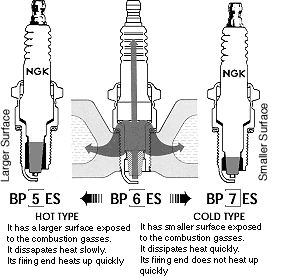We sell stock heat range, as well as colder range plugs for several different vehicles and we get asked This explanation is from our friends over at NGK.
A spark plug’s heat range has no relationship to the actual voltage transferred through the spark plug. Rather, the heat range is a measure of the spark plug’s ability to remove heat from the combustion chamber. The heat range measurement is determined by several factors; the length of the ceramic center insulator nose and its’ ability to absorb and transfer combustion heat, the material composition of the insulator and center electrode material.

The insulator nose length is the distance from the firing tip of the insulator to the point where insulator meets the metal shell. Since the insulator tip is the hottest part of the spark plug, the tip temperature is a primary factor in pre-ignition and fouling. Whether the spark plugs are fitted in a lawnmower, boat, or a race car, the spark plug tip temperature must remain between 500C-850°C. If the tip temperature is lower than 500°C, the insulator area surrounding the center electrode will not be hot enough to burn off carbon and combustion chamber deposits. These accumulated deposits can result in spark plug fouling leading to misfire. If the tip temperature is higher than 850°C the spark plug will overheat which may cause the ceramic around the center electrode to blister and the electrodes to melt. This may lead to pre-ignition/detonation and expensive engine damage. In identical spark plug types, the difference from one heat range to the next is the ability to remove approximately 70°C to 100°C from the combustion chamber. A projected style spark plug firing tip temperature is increased by 10°C to 20°C.
